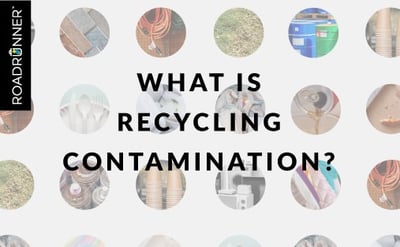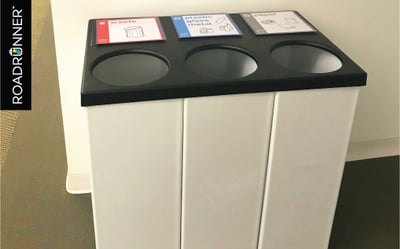Launching a recycling program at your business is a great way to reduce waste, minimize your environmental footprint, and lower waste costs. If you're setting out to begin recycling at your business, we want you to be as informed as possible. In this blog post, we rounded up the best resources we've created to help you get informed and increase your chances of launching a successful initiative.
Top 6 Resources for Starting A Commercial Recycling Program
Click on the links or images below to explore six areas of recycling you need to consider before getting started:
What Is Recycling Contamination?
Recycling contamination occurs when non-recyclable materials end up in a recycling container or when recyclables are not properly cleaned and dry. For example, when food and liquids remain on or inside plastic containers, that plastic is considered contaminated. A single contaminated material can render an entire container non-recyclable. Further, waste haulers may not service your containers, or the contaminated load may force your hauler to send the materials directly to landfills. Either way, contamination puts your business at risk for additional charges and fees. Before starting your recycling program, familiarize yourself with our post to learn which common contaminates to look out for and the best practices for keeping your recyclables contaminant-free.
How to choose the right internal receptacles for waste & recycling
When it comes to maximizing the results of your recycling program, choosing the right internal waste and recycling receptacles is very important. Waste and recycling containers come in many different shapes, sizes, and colors. Before purchasing containers, review this post to gain a comprehensive understanding of each of the waste and recycling containers on the market to help you determine which receptacle system aligns best with your business' requirements.
THE BENEFITS OF CENTRALIZED COLLECTION POINTS
Removing desk-side bins and introducing centralized collection points throughout your building can have an immediate impact on your staff’s recycling habits. It's easy for individuals to toss recyclable materials in their desk-side bins without thinking twice about it. But making the swap to centralized collection points requires individuals to walk to the containers and become more aware of the materials they throw away. Read our post to learn more about the benefits of centralized collection points, real-world success stories, and how to set up the collection points in your office.
Waste & recycling signage best practices
Using signage on your waste and recycling receptacles is, without a doubt, the best way to educate your employees and reinforce expectations to participation in your recycling initiatives. Recycling can be confusing, but t
Before you kick-off your recycling program, scheduling recycling training sessions with your employees will ensure they have a clear understanding of how it works and increase overall participation. In this blog post, we share everything you need to know about employee recycling training, as well as a free downloadable training presentation that you can use with your staff.
VIEW these resources if you're interested in learning more
- The Ultimate Guide to the Dos and Don'ts of Recycling
- Your Go-To Checklist for Starting an Office Recycling Program
- Recycling and Waste Terms Every Business Should Know
If you need help getting started, RoadRunner can develop a waste and recycling program tailored to your business' needs. Set aside some time to speak with one of our representatives! Click here to schedule a meeting today.

